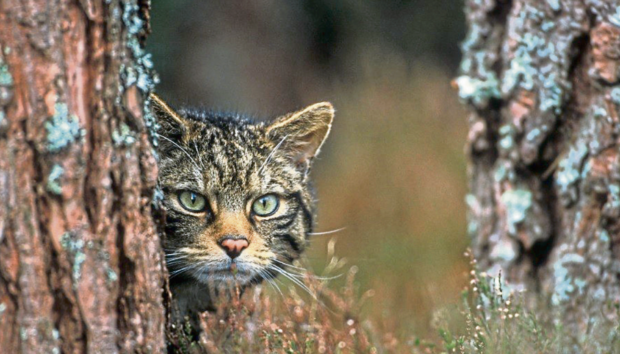On a misty spring evening, two men dedicated to protecting one of Scotland’s most enigmatic creatures survey their surroundings.
There is pristine woodland to their backs,and a vast moor of recently-felled forest in front of them.
They point to one particular stump, where just months previously, a special low-light trail camera had triggered, capturing an image of one of the 13 purebred Scottish wildcats living and breeding in the Clashindarroch area, south-west of Huntly.
But now fears have been raised that without immediate action from the Scottish Government, the tiny population of wildcats in the region – some of the last in Scotland – could be lost forever to make way for windfarms and toilet paper production.
Researchers Kevin Bell and Steve Sleigh volunteer for the grassroots organisation Wildcat Haven, a group that seeks to safeguard the future of the critically endangered predator, which is sometimes known as the Highland Tiger.
Since 2015, the pair have spent countless evenings tracking the furtive felines throughout the remote Clashindarroch.
By looking for tiny paw prints on game trails, searching for kill sites, identifying scratching posts and setting up hidden camera traps, Mr Bell and Mr Sleigh are able to observe the fearsome animals without disturbing them.
Through the use of pungent mackerel fillets as bait and dozens of other tricks of the trade, the researchers say they have confirmed at least 13 pure Scottish wildcats living and hunting in the forests.
Although other organisations estimate there are hundreds of genetically pure cats left in the wild, Wildcat Haven – which uses very stringent criteria to determine whether or not an individual is a true wildcat or not – believe the 13 cats of Clashindarroch represent around a third of the remaining unhybridised Scottish wildcats in the world.
And to protect the iconic animal’s future, Wildcat Haven has today launched a campaign to give the Clashindarroch region special designation as a protected site and prevent any further deforestation or development.
Forestry Enterprise Scotland (FES), the forestry directorate of the Scottish Government, manages the forests of Clashindarroch.
Wildcat Haven says the commission currently plans to allow for up to 60% of the area’s woodland to be felled over the next 15 to 20 years – and proposals have been put forward for windfarms in the region.
Mr Bell said: “We’re appalled by what’s going on.
“The exact areas where we’ve photographed wildcats just weeks ago are now being clear-felled for toilet roll, and set aside for windfarm installations.
“This is the last viable population of Scottish wildcats left anywhere, and the FCS, while publicly claiming to be protecting them, are actively chopping down their home around them.
“This is a national scandal – we’re at risk of losing our iconic wildcat to these thoughtless actions.”
Last night, a spokesman for FES said: “We welcome Wildcat Haven’s continued interest in our forest management and for giving us the opportunity to promote and explain the integrated and vital work being done through Scottish Wildcat Action to save Scotland’s wildcats.”
Wildcats were once widespread across the UK, but the purebreds are now on the brink of extinction due to persecution, disease, and cross-breeding with feral domestic cats.
But one of the largest threats facing the ferocious felines is loss of suitable habitat.
Although the predators can adapt to many of Scotland’s natural environments and can have very large territories, a spokesman for Wildcat Haven said they particularly thrive in woodlands, as they provide cover to stalk prey, and most importantly, to create dens for their kittens.
If mother cats with kittens are disturbed, it is not unknown for them to abandon, or even worse, eat their own young.
Mr Sleigh said that in addition to wildcats, he and Mr Bell have captured plenty of other threatened animals on camera in the forests, including pine martens and the charismatic red squirrel.
He added: “Clashindarroch forest must be protected from further commercial exploitation immediately and without compromise, it’s too important.
“This place needs to be left alone, and we’re determined to get this forest and these wildcats full legal protection from commercial exploitation.
“We need MSPs to bring this to parliament, because Nicola Sturgeon needs to understand that Scotland’s iconic wildcat is about to be lost on her watch.”
Using their strict criteria of ensuring a cat meets 19 out of 21 special factors to determine genetic purity, Wildcat Haven believes there could be as few as 35 true individuals left in Scotland.
By analysing patterns on their tails, body, necks, backs and a number of other tell-tale indicators, the group’s researchers can both identify the number of individuals in local populations and determine if they are hybrids or not.
In addition to conservation work in Clashindarroch, the organisation also works to protect a population of around 10 wildcats it has identified in west Lochaber, where they have carried out a project to neuter domestic cats in the region in order to prevent cross-breeding.
